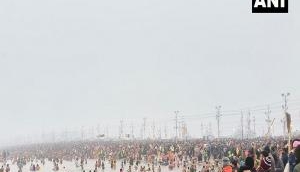Trial by media: three senior journalists put their jobs under the microscope

When the media talks about itself, what does it have to say? Three experienced editors and journalists came together on the final day of the Jaipur Literature Festival on the phenomenon of trial by media.
It's gone from being an exceptional occurence to the norm. Every night, with gaudy tickers and, in some cases, flames dancing across the screen, public opinion on issues is moulded, not through information as much as noise, opinion and speculation presented as facts. Those pronounced 'guilty' are pilloried and slandered on national media for the country's appeasement.
And we lap it up, because it caters to the latent schadenfreude of the country, much like the carnival-esqe feel of a medieval public hanging. But while an execution puts an end to the ordeal of the 'accused', trial by media is only the beginning of the end.
Watch - The internet is a disorderly 18th century salon: Jerry Pinto #JLF2016
Assembled to discuss the phenomenon and examine the extent of the media's culpability were journalists Shoma Chaudhury, editor-in-chief of CatchNews, Madhu Trehan, editor of Newslaundry, and Avirook Sen, author of Aarushi.
While all panelists acknowledged that the media was culpable in jumping to conclusions, Trehan was at pains to highlight that good, solid reporting continues to happen.
Unfortunately, it rarely seems to generate eyeballs.
Apart from the obvious need to attract mass audiences, there's another key factor at play, according to Chaudhury: our collective obsession as media to be 'first'.
In this race for exclusives and breaking news, journalistic standards take a backseat. We won't be able to privilege substantiveness and credibility if speed is the only criteria, she argued, saying it's time to shift from instant news to a more informed, even if slightly slower system.
Both Sen - who had a ringside view to the media trial of Nupur and Rajesh Talwar - as well as Chaudhury, who has reported extensively on the subject, used the Aarushi trial as a recurring example of the way the media influences perception. Sen reminded the audience of how the Talwars were denied bail in an Allahabad High Court as a result of the judge being seemingly influenced by the media. Trehan was even less ambiguous: the media was responsible for the Talwars being in jail, she said.
But acknowledging the problem, however important, doesn't solve it. And that, to the panel was a core of the problem: unless there are consequences to media misreporting, it will continue to happen at destructive scale. Sen went as far as to say that, forget reparations, the media can barely own up to their mistakes.
The concept of reparations for the aggrieved parties was broached, but everyone agreed that legal action in the country took too long for it to be accessible to the common man. Apart from censoring the viewpoints of those being pilloried in media trials, the panelists also discussed how the media at times censors itself, usually to curry favour with those in power.
Ultimately though, when it comes to media trials, Sen believed that they only existed because of a public appetite for them. The final consensus of the panel was that the media needed to introspect and ask itself whether it's duty is to its viewers need for Ekta Kapoor-style drama, or their need for information. Let's hope it's the latter they heed to.
More in Catch - #60Seconds with Kwame Anthony Appiah: growing up homosexual in Ghana
#60Seconds with Valmik Thapar: "Tiger count hasn't increased. We're just counting better"
#60Seconds with Marlon James: 'West loves fairies & hobbits. I'm kinda tired'







![BJP's Kapil Mishra recreates Shankar Mahadevan’s ‘Breathless’ song to highlight Delhi pollution [WATCH] BJP's Kapil Mishra recreates Shankar Mahadevan’s ‘Breathless’ song to highlight Delhi pollution [WATCH]](https://images.catchnews.com/upload/2022/11/03/kapil-mishra_240884_300x172.png)

![Anupam Kher shares pictures of his toned body on 67th birthday [MUST SEE] Anupam Kher shares pictures of his toned body on 67th birthday [MUST SEE]](https://images.catchnews.com/upload/2022/03/07/Anupam_kher_231145_300x172.jpg)






